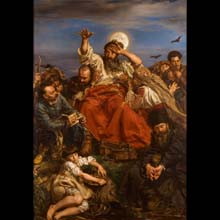
material: oil on canvas
dimensions: 290 × 204 cm
description: Wernyhora – Ukrainian bandurist and bard, whose actual existence is still disputed by many, allegedly lived in the second half of the 18th century at the time of the so-called Koliyivschyna - a peasant rebellion in Ukraine, which he fervently opposed. Wernyhora’s prophecies centred on the future of both Poland and Ukraine. The clairvoyant foretold of the partitions of Poland, the failed uprising and the rebirth of the Polish state thanks to England and Turkey. Matejko started working on the painting in the 1870s, at a time when the relationship between Ruthenians and Poles in Ukraine became increasingly more fraught, due to national and religious reasons. Wernyhora is pictured while prophesying. With an eastern cross on his chest, he is a symbol of the “old Ukraine of Lachs and Ruthenians, a land of national and social rapport”. The lira at his feet stands for songs which safeguard the common Polish-Ukrainian legacy. The nobleman sitting at the prophet’s left is noting down the word of the prophecy: “The Poles will fail in their efforts, and Poland will be torn asunder three times. Many will strive to rebuild it, but all shall fail. A great man shall come from the west and Poles shall offer themselves in his service; he shall promise them a lot, but little will he do: though calling themselves a nation again, they shall wail under the yoke of Germans and Russians”
Wacława Milewska
exposition: The Gallery of 19th Century Polish Art in Sukiennice,
The Cloth Hall, 1, Main Market Square
key: Around the academy >>>
dimensions: 290 × 204 cm
description: Wernyhora – Ukrainian bandurist and bard, whose actual existence is still disputed by many, allegedly lived in the second half of the 18th century at the time of the so-called Koliyivschyna - a peasant rebellion in Ukraine, which he fervently opposed. Wernyhora’s prophecies centred on the future of both Poland and Ukraine. The clairvoyant foretold of the partitions of Poland, the failed uprising and the rebirth of the Polish state thanks to England and Turkey. Matejko started working on the painting in the 1870s, at a time when the relationship between Ruthenians and Poles in Ukraine became increasingly more fraught, due to national and religious reasons. Wernyhora is pictured while prophesying. With an eastern cross on his chest, he is a symbol of the “old Ukraine of Lachs and Ruthenians, a land of national and social rapport”. The lira at his feet stands for songs which safeguard the common Polish-Ukrainian legacy. The nobleman sitting at the prophet’s left is noting down the word of the prophecy: “The Poles will fail in their efforts, and Poland will be torn asunder three times. Many will strive to rebuild it, but all shall fail. A great man shall come from the west and Poles shall offer themselves in his service; he shall promise them a lot, but little will he do: though calling themselves a nation again, they shall wail under the yoke of Germans and Russians”
Wacława Milewska
exposition: The Gallery of 19th Century Polish Art in Sukiennice,
The Cloth Hall, 1, Main Market Square
key: Around the academy >>>












